Re-Examination of the Decadal Change in the Relationship between the East Asian Summer Monsoon and Indian Ocean SST
Abstract
1. Introduction
2. Data and Methodology
3. Decadal Change in the Relationship between the Tropical IO-East Asian Summer Monsoon
3.1. Examining the Revisited Relationship between the Tropical IO-EASM
3.2. Changed Influence of the EASMI on the East Asian Summer Circulation
3.3. Influence of the IO SSTA Patterns on Summer Circulation Anomalies in East Asia
4. Possible Causes for the Change in Relationship between Tropical IO and EASM
5. Discussion and Conclusions
Author Contributions
Funding
Acknowledgments
Conflicts of Interest
References
- Lau, K.M.; Yang, S. Climatology and interannual variability of the Southeast Asian summer monsoon. Adv. Atmos. Sci. 1997, 14, 141–162. [Google Scholar] [CrossRef]
- Ding, Y.H.; Chan, J.C.L. The East Asian summer monsoon: An overview. Meteorol. Atmos. Phys. 2005, 89, 117–142. [Google Scholar] [CrossRef]
- Murakami, T.; Matsumoto, J. Summer monsoon over the Asian continent and the Western North Pacific. J. Meteorol. Soc. Jpn. 1994, 72, 719–745. [Google Scholar] [CrossRef]
- Ha, K.J.; Lee, J.Y.; Wang, B.; Xie, S.P.; Kitoh, A. Asian Monsoon Climate Change—Understanding and Prediction. Asia Pac. J. Atmos. Sci. 2017, 53, 179–180. [Google Scholar] [CrossRef]
- Moon, S.Y.; Ha, K.J. Temperature and Precipitation in the context of the annual cycle over Asia: Model evaluation and future change. Asia Pac. J. Atmos. Sci. 2017, 53, 229–242. [Google Scholar] [CrossRef]
- Huang, R.; Chen, J.; Wang, L.; Lin, Z. Characteristics, processes, and causes of the spatio-emporal variabilities of the East Asian monsoon system. Adv. Atmos. Sci. 2012, 29, 910–942. [Google Scholar] [CrossRef]
- Lau, K.M. East Asian summer monsoon rainfall variability and climate teleconnection. J. Meteorol. Soc. Jpn. 1992, 70, 211–242. [Google Scholar] [CrossRef]
- Wang, B.; Bao, Q.; Hoskins, B.; Wu, G.; Liu, Y. Tibetan Plateau warming and precipitation changes in East Asia. Geophys. Res. Lett. 2008, 35, L14702. [Google Scholar] [CrossRef]
- Wang, B.; Wu, R.; Fu, X. Pacific-East Asian teleconnection: How does ENSO affect East Asian climate? J. Clim. 2000, 13, 1517–1536. [Google Scholar] [CrossRef]
- Wu, R.; Hu, Z.Z. Evolution of ENSO-Related Rainfall Anomalies in East Asia. J. Clim. 2003, 16, 3742–3758. [Google Scholar] [CrossRef]
- Shen, S.; Lau, K.M. Biennial oscillation associated with the East Asian summer monsoon and tropical sea surface temperatures. J. Meteorol. Soc. Jpn. 1995, 73, 105–124. [Google Scholar] [CrossRef]
- Chang, C.P.; Zhang, Y.S.; Li, T. Interannual and interdecadal variations of the East Asian summer monsoon and tropical Pacific SSTs. Part I: Roles of the subtropical ridge. J. Clim. 2000, 13, 4310–4325. [Google Scholar] [CrossRef]
- Liu, X.; Yanai, M. Influence of Eurasian spring snow cover on Asian summer rainfall. Int. J. Climatol. 2002, 22, 1075–1089. [Google Scholar] [CrossRef]
- Wu, G.X.; Liu, Y.M.; Li, W.P. Impacts of the sea surface temperature anomaly in the Indian Ocean on the subtropical anticyclone over the western Pacific? Two-stage thermal adaptation in the atmosphere. Acta Meteorol. Sin. 2000, 58, 513–522. [Google Scholar]
- Huang, R.H.; Wu, Y.F. The influence of ENSO on the summer climate change in China and its mechanism. Adv. Atmos. Sci. 1989, 6, 21–32. [Google Scholar] [CrossRef]
- Zhang, R.H.; Sumi, A.; Kimoto, M. Impact of El Niño on the East Asian monsoon. J. Meteorol. Soc. Jpn. 1996, 74, 49–62. [Google Scholar] [CrossRef]
- Lau, K.M.; Weng, H.Y. Coherent modes of global SST and summer rainfall over China: An assessment of the regional impacts of the 1997/98 El Niño. J. Clim. 2001, 14, 1294–1308. [Google Scholar] [CrossRef]
- Oh, H.; Ha, K.J. Thermodynamic characteristics and responses to ENSO of dominant intraseasonal modes in the East Asian summer monsoon. Clim. Dyn. 2015, 44, 1751–1766. [Google Scholar] [CrossRef]
- Gong, D.Y.; Zhu, J.; Wang, S. Significant relationship between spring AO and the summer rainfall along the Yangtze River. Chin. Sci. Bull. 2002, 47, 948–952. [Google Scholar] [CrossRef]
- Gong, D.Y.; Ho, C.H. Arctic oscillation signals in the East Asian summer monsoon. J. Geophys. Res. 2003, 108, 4066. [Google Scholar] [CrossRef]
- Ding, R.Q.; Ha, K.J.; Li, J.P. Interdecadal shift in the relationship between the East Asian summer monsoon and the tropical Indian Ocean. Clim. Dyn. 2010, 34, 1059–1071. [Google Scholar] [CrossRef]
- Hu, Z.Z. Interdecadal variability of summer climate over East Asia and its associated with 500 hPa height and global sea surface temperature. J. Geophys. Res. 1997, 102, 19403–19412. [Google Scholar] [CrossRef]
- Wu, R.; Wang, B. A contrast of the east Asian summer monsoon-ENSO relationship between 1962–77 and 1978–93. J. Clim. 2002, 15, 3266–3279. [Google Scholar] [CrossRef]
- Zhu, J.; Huang, D.Q.; Qian, Y.F.; Lin, H.J. Uneven characteristics of warm extremes during Meiyu period over Yangtze-Huaihe region and its configuration with circulation systems (in Chinese). Chin. J. Geophys. Chin. 2010, 53, 2310–2320. [Google Scholar] [CrossRef]
- Huang, Y.; Wang, B.; Li, X.; Wang, H. Changes in the influence of the western Pacific subtropical high on Asian summer monsoon rainfall in the late 1990s. Clim. Dynam. 2018, 51, 443–455. [Google Scholar] [CrossRef]
- Li, J.P.; Zeng, Q.C. A unified monsoon index. Geophys. Res. Lett. 2002, 29, 1274. [Google Scholar] [CrossRef]
- Wang, B.; Wu, Z.; Li, J.; Liu, J.; Chang, C.-P.; Ding, Y.; Wu, G. How to measure the strength of the East Asian summer monsoon. J. Clim. 2008, 21, 4449–4462. [Google Scholar] [CrossRef]
- Saji, N.H.; Goswami, B.N.; Vinayachandran, P.N.; Yamagata, T. A dipole mode in the tropical Indian Ocean. Nature 1999, 401, 360–363. [Google Scholar] [CrossRef] [PubMed]
- Du, Y.; Xie, S.P.; Huang, G.; Hu, K. Role of Air-Sea Interaction in the Long Persistence of El Niño-Induced North Indian Ocean Warming. J. Clim. 2009, 22, 2023–2038. [Google Scholar] [CrossRef]
- Xie, S.P.; Deser, C.; Vecchi, G.A.; Ma, J.; Teng, H.; Wittenberg, A.T. Global Warming Pattern Formation: Sea Surface Temperature and Rainfall. J. Clim. 2009, 23, 966–986. [Google Scholar] [CrossRef]
- Livezey, R.E.; Chen, W.Y. Statistical Field Significance and its Determination by Monte Carlo Techniques. Mon. Weather Rev. 1983, 111, 46–59. [Google Scholar] [CrossRef]
- Nitta, T. Convective activities in the tropical western Pacific and their impact on the Northern Hemisphere summer circulation. J. Meteorol. Soc. Jpn. 1987, 64, 373–390. [Google Scholar] [CrossRef]
- Huang, R.H.; Sun, F.Y. Impact of the tropical western Pacific on the East Asian summer monsoon. J. Meteorol. Soc. Jpn. 1992, 70, 243–256. [Google Scholar] [CrossRef]
- Webster, P.J.; Magana, V.O.; Palmer, T.N.; Shukla, J.; Tomas, R.A.; Yanai, M.; Yasunari, T. Monsoons: Processes, predictability, and the prospects for prediction. J. Geophys. Res. 1998, 103, 14451–14510. [Google Scholar] [CrossRef]
- Wu, Z.; Wang, B.; Li, J.; Jin, F.F. An empirical seasonal prediction model of the East Asian summer monsoon using ENSO and NAO. J. Geophys. Res. 2009, 114. [Google Scholar] [CrossRef]
- Wu, Z.; Li, J.; Jiang, Z.; He, J.; Zhu, X. Possible effects of the North Atlantic Oscillation on the strengthening relationship between the East Asian Summer monsoon and ENSO. Int. J. Climatol. 2012, 32, 794–800. [Google Scholar] [CrossRef]
- Xie, S.P.; Hu, K.; Hafner, J.; Tokinaga, H.; Du, Y.; Huang, G.; Sampe, T. Indian Ocean Capacitor Effect on Indo-Western Pacific Climate during the Summer following El Niño. J. Clim. 2008, 22, 730–747. [Google Scholar] [CrossRef]
- Sun, Y.; Ding, Y. Responses of south and east Asian summer monsoons to different land-sea temperature increases under a warming scenario. Chin. Sci. Bull. 2011, 56, 2718–2726. [Google Scholar] [CrossRef]
- Kim, K.Y.; Kim, Y.Y. Mechanism of Kelvin and Rossby waves during ENSO events. Meteorol. Atmos. Phys. 2002, 81, 169–189. [Google Scholar] [CrossRef]
- Wang, B.; An, S.I. A method for detecting season-dependent modes of climate variability: S-EOF analysis. Geophys. Res. Lett. 2005, 32, L15710. [Google Scholar] [CrossRef]
- Bejarano, L.; Jin, F.F. Coexistence of equatorial coupled modes of ENSO. J. Clim. 2008, 21, 3051–3067. [Google Scholar] [CrossRef]
- Yun, K.S.; Ha, K.J.; Yeh, S.W.; Wang, B.; Xiang, B. Critical role of boreal summer North Pacific subtropical highs in ENSO transition. Clim. Dyn. 2015, 44, 1979–1992. [Google Scholar] [CrossRef]
- Webster, P.J.; Palmer, T.N. The past and the future of El Niño. Nature 1997, 390, 562–564. [Google Scholar] [CrossRef]
- Kumar, K.K.; Rajagopalan, B.; Cane, M.A. On the weakening relationship between Indian monsoon and ENSO. Science 1999, 284, 2156–2159. [Google Scholar] [CrossRef] [PubMed]
- Wang, B.; Huang, F.; Wu, Z.W.; Yang, J.; Fu, X.; Kikuchi, K. Multi-scale Climate Variability of the South China Sea Monsoon: A review. Dynam. Atmos. Oceans 2009, 47, 15–37. [Google Scholar] [CrossRef]
- Li, J.P.; Wu, Z.W.; Jiang, Z.H.; He, J.H. Can global warming strengthen the East Asian summer monsoon? J. Clim. 2010. [Google Scholar] [CrossRef]
- Roy, I. Indian Summer Monsoon and El Niño Southern Oscillation in CMIP5 Models: A Few Areas of Agreement and Disagreement. Atmosphere 2017, 8, 154. [Google Scholar] [CrossRef]
- Rasmusson, E.M.; Wang, X.; Ropelewski, C.F. The biennial component of ENSO variability. J. Mar. Syst. 1990, 1, 71–96. [Google Scholar] [CrossRef]
- Vecchi, G.A.; Soden, B.J. Global warming and the weakening of the tropical circulation. J. Clim. 2007, 20, 4316–4340. [Google Scholar] [CrossRef]
- Vecchi, G.A.; Soden, B.J.; Wittenberg, A.T.; Held, I.M.; Leetmaa, A.; Harrison, M.J. Weakening of tropical Pacific atmospheric circulation due to anthropogenic forcing. Nature 2006, 441, 73–76. [Google Scholar] [CrossRef] [PubMed]
- Yun, K.S.; Yeh, S.W.; Ha, K.J. Covariability of western tropical Pacific-North Pacific atmospheric circulation during summer. Sci. Rep. 2015, 5, 16980. [Google Scholar] [CrossRef] [PubMed]
- Nicholson, S.E. An analysis of the ENSO signal in the tropical Atlantic and western Indian Oceans. Int. J. Climatol. 1997, 17, 345–375. [Google Scholar] [CrossRef]
- Alexander, M.A.; Blade, I.; Newman, M.; Lanzante, J.R.; Lau, N.C.; Scott, J.D. The Atmospheric Bridge: The Influence of ENSO Teleconnections on Air-Sea Interaction over the Global Oceans. J. Clim. 2002, 15, 2205–2231. [Google Scholar] [CrossRef]
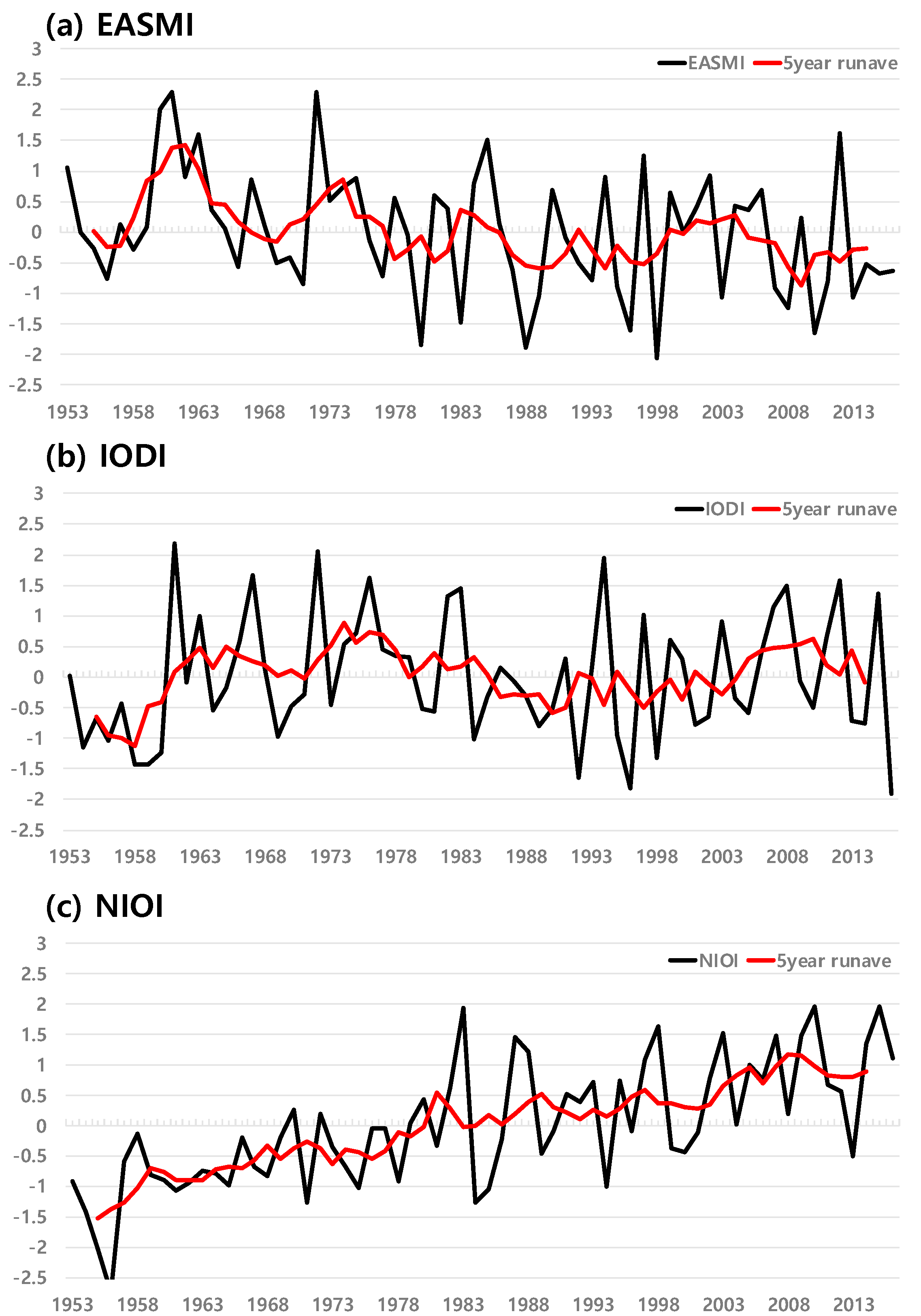
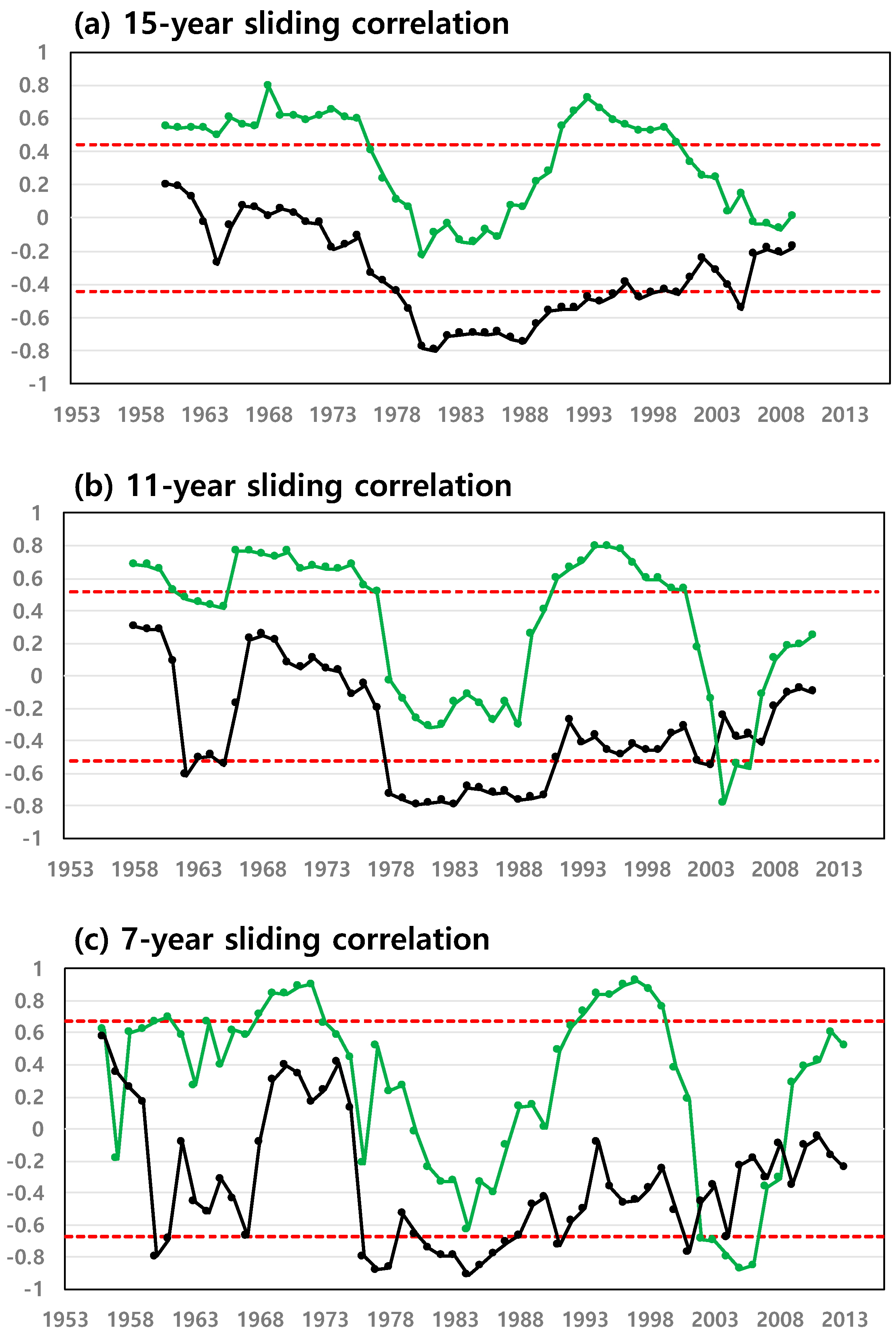

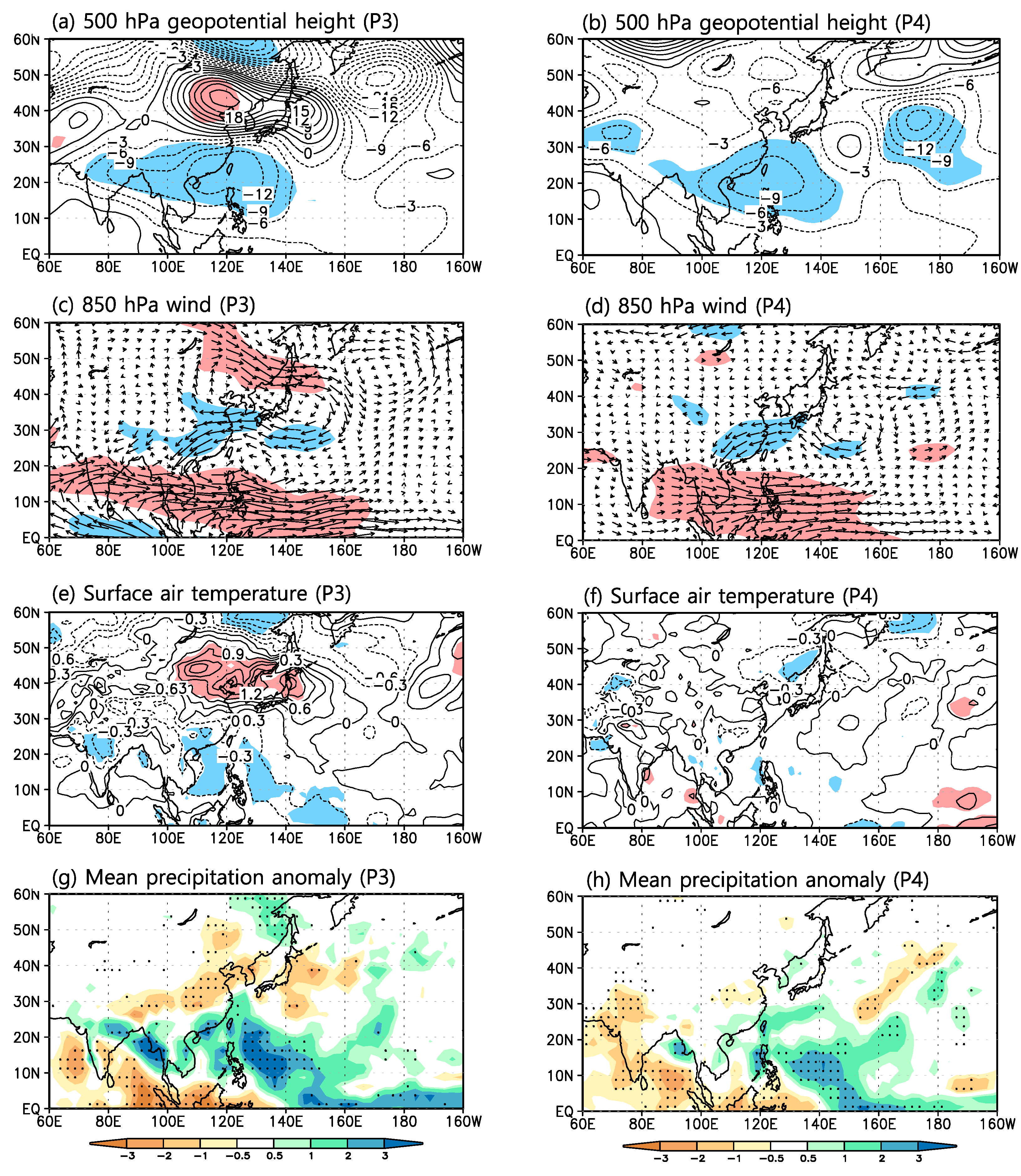

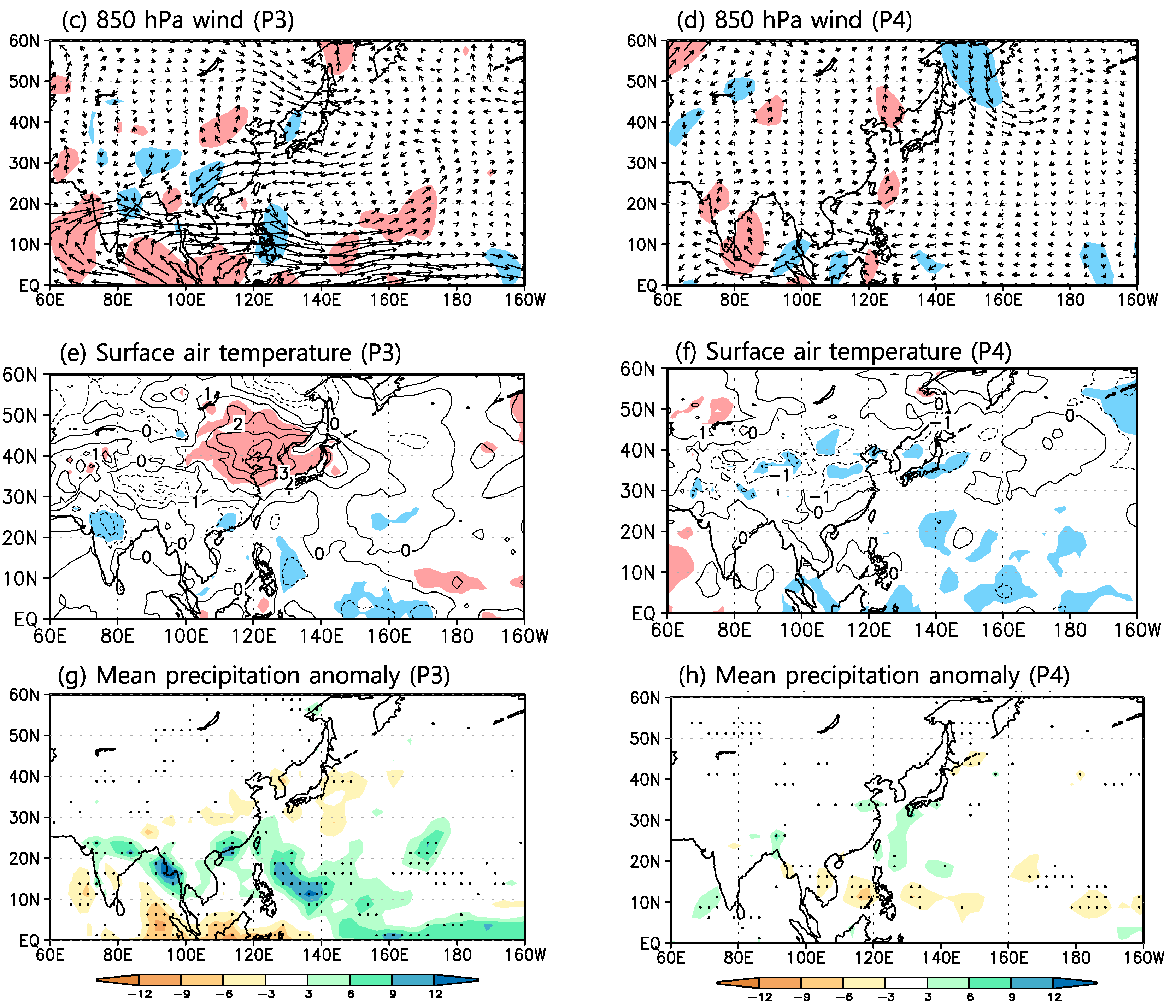
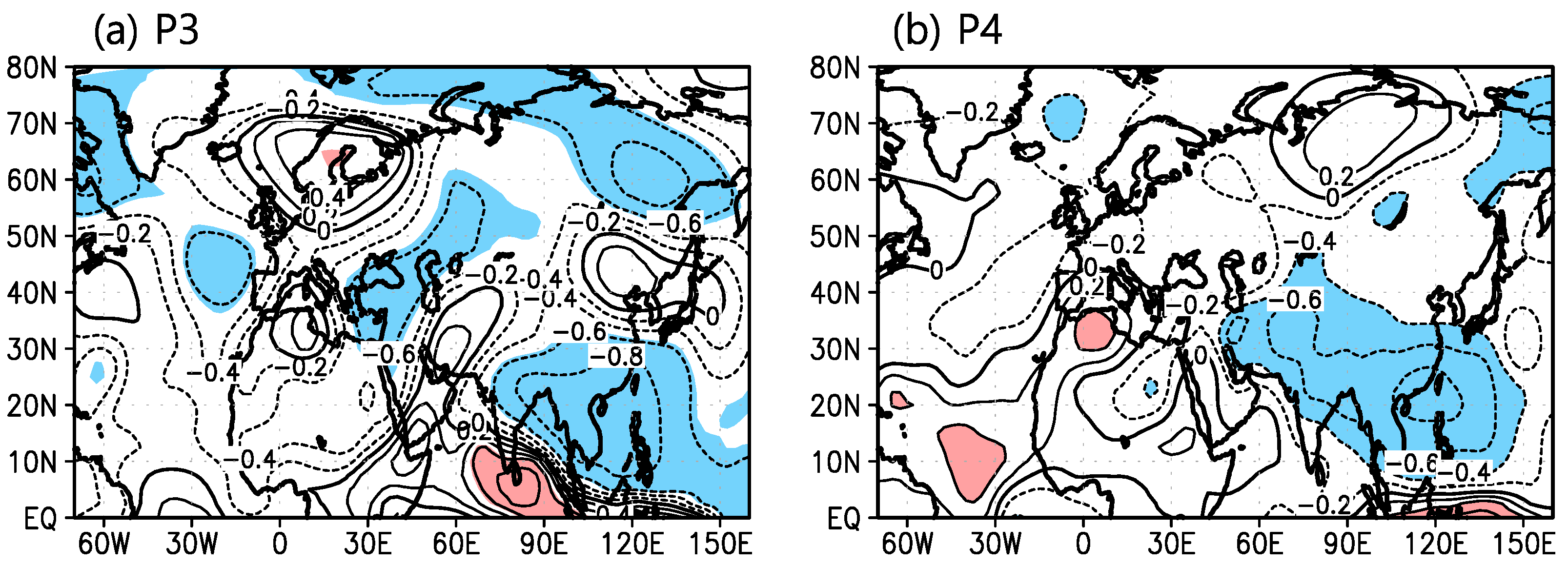
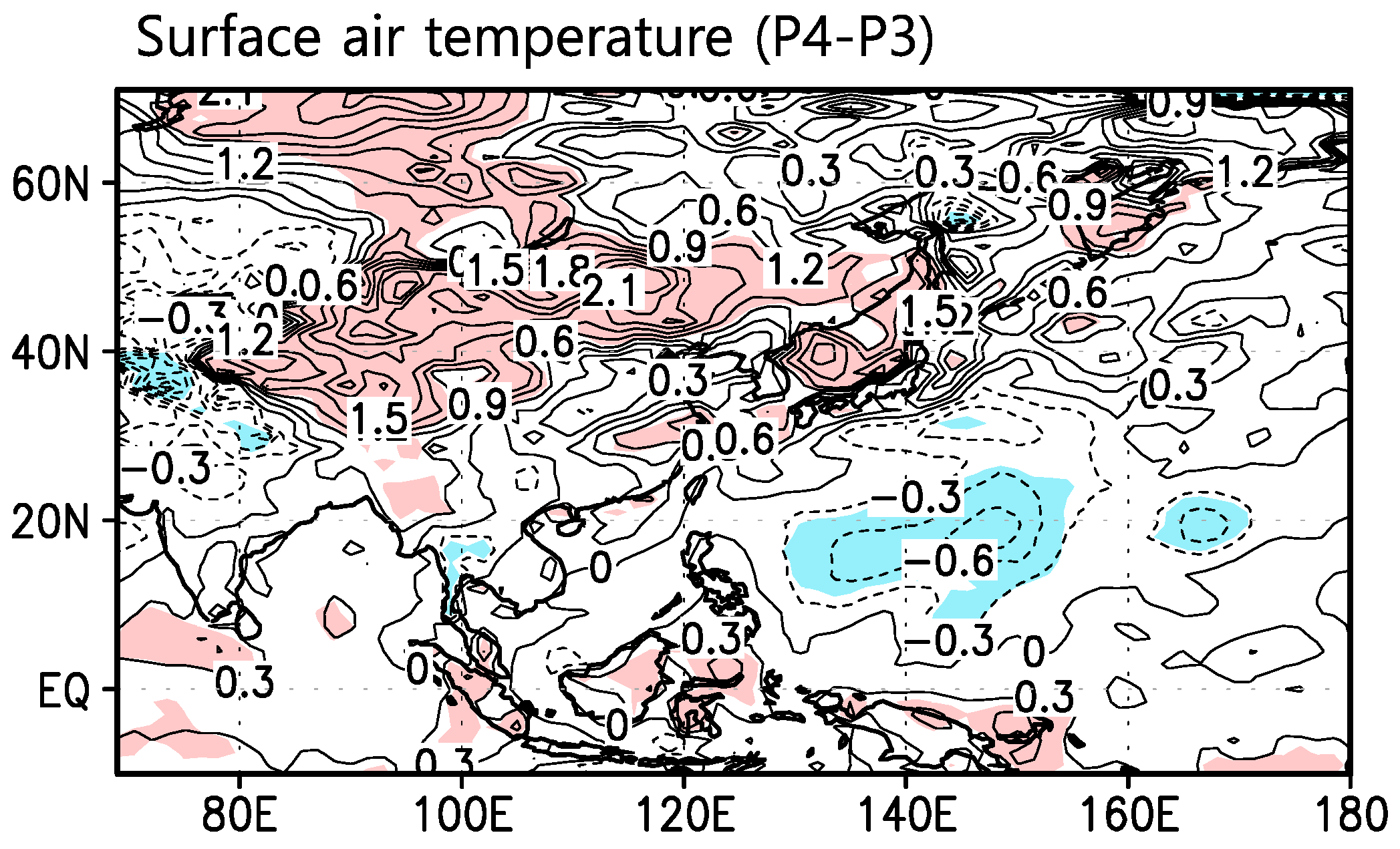
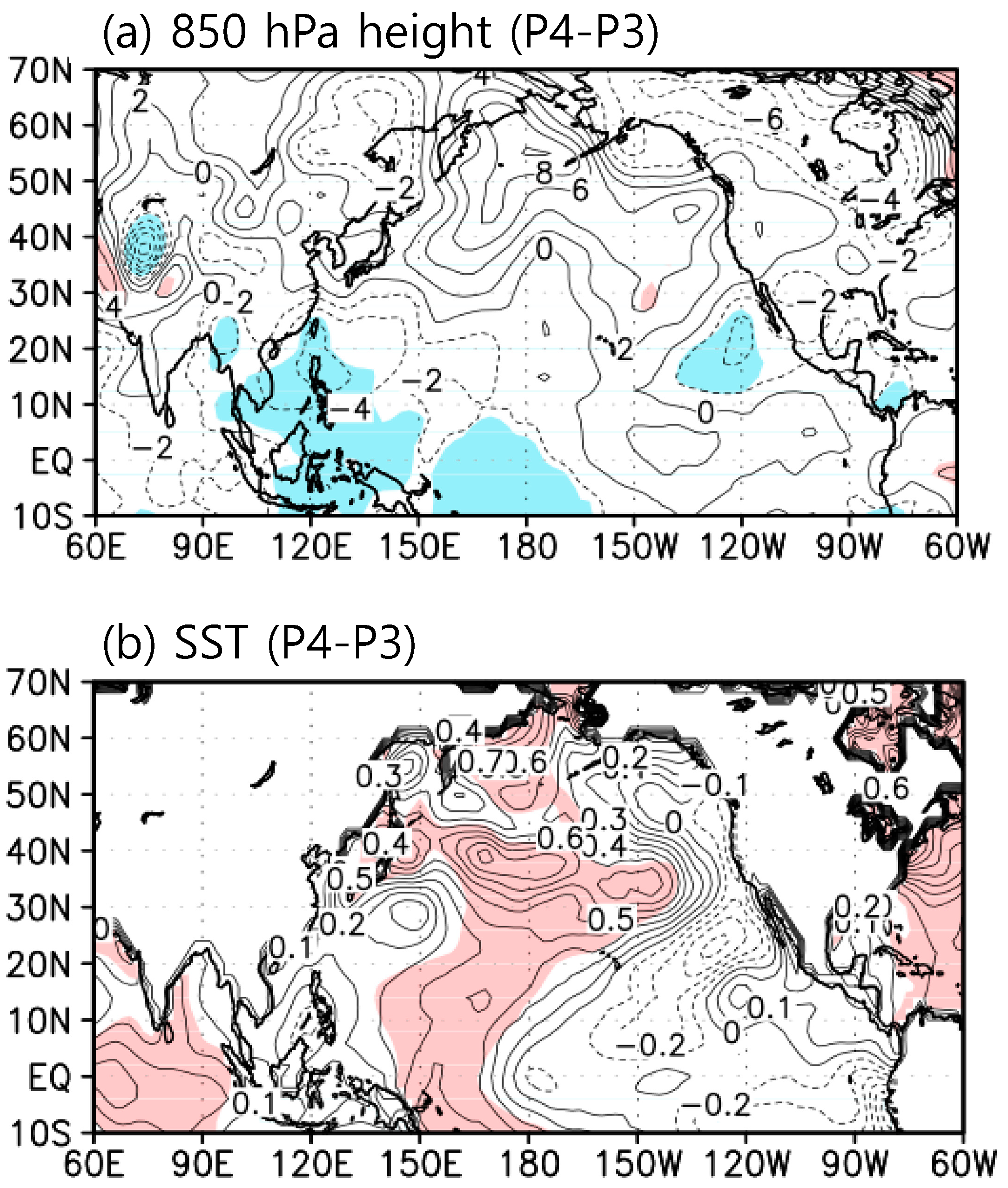
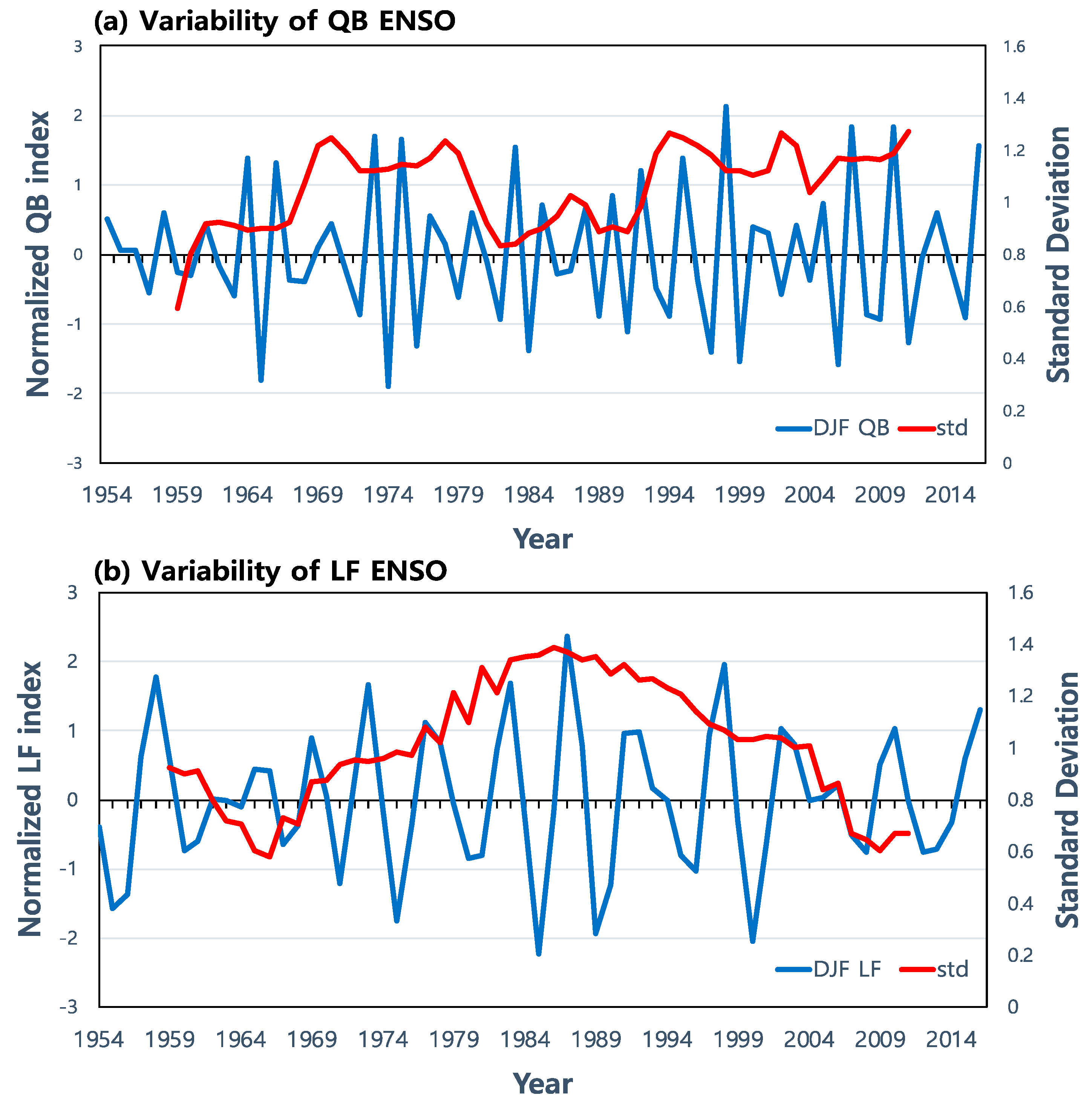
| Data | NCEP/NCAR | ERA-interim | GPCP | ERSST |
|---|---|---|---|---|
| Variables | UV 850 hPa, Z 500 hPa | 2 m T | Precipitation | SST |
| Analysis Period | 1953–2016 | 1979–2016 | 1979–2016 | 1953–2016 |
© 2018 by the authors. Licensee MDPI, Basel, Switzerland. This article is an open access article distributed under the terms and conditions of the Creative Commons Attribution (CC BY) license (http://creativecommons.org/licenses/by/4.0/).
Share and Cite
Kim, S.; Ha, K.-J.; Ding, R.; Li, J. Re-Examination of the Decadal Change in the Relationship between the East Asian Summer Monsoon and Indian Ocean SST. Atmosphere 2018, 9, 395. https://doi.org/10.3390/atmos9100395
Kim S, Ha K-J, Ding R, Li J. Re-Examination of the Decadal Change in the Relationship between the East Asian Summer Monsoon and Indian Ocean SST. Atmosphere. 2018; 9(10):395. https://doi.org/10.3390/atmos9100395
Chicago/Turabian StyleKim, Seogyeong, Kyung-Ja Ha, Ruiqiang Ding, and Jiangping Li. 2018. "Re-Examination of the Decadal Change in the Relationship between the East Asian Summer Monsoon and Indian Ocean SST" Atmosphere 9, no. 10: 395. https://doi.org/10.3390/atmos9100395
APA StyleKim, S., Ha, K.-J., Ding, R., & Li, J. (2018). Re-Examination of the Decadal Change in the Relationship between the East Asian Summer Monsoon and Indian Ocean SST. Atmosphere, 9(10), 395. https://doi.org/10.3390/atmos9100395




